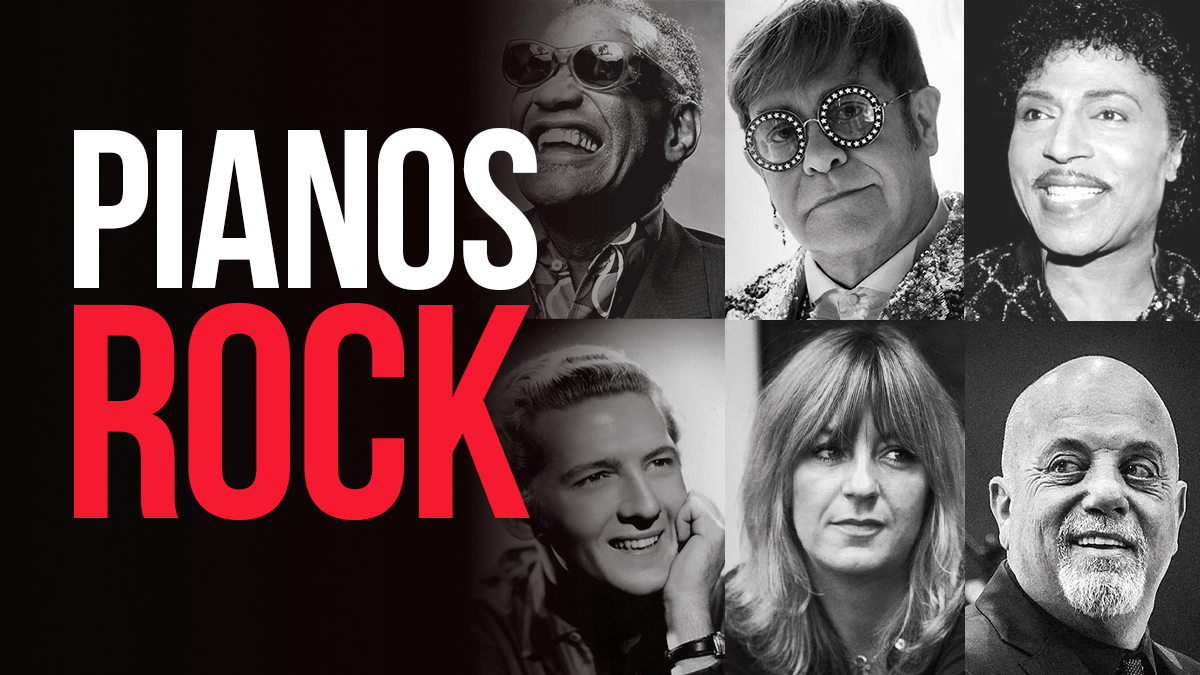
Who says there aren’t piano rock songs? The piano isn’t just for peaceful classical music or relaxing jazz. In fact, it has a long history in rock’n’roll. Here are some hard-hitting piano rock songs that prove the piano can hold its own in one of the world’s most beloved genres of music. Songs are listed in chronological order.
Inspiring tutorials. Fascinating articles. Exclusive interviews. We create piano content anyone, anywhere can enjoy for free. Don’t miss out, sign up for more free lessons.
Pianist: Little Richard
Ultimate Guitar Chord Chart
Wop bop a loo bop a lop ba ba! Led Zeppelin guitarist Brian May said that the true originators of rock music weren’t guitarists, but pianists Little Richard and Jerry Lee Lewis. Don’t be fooled by the sweet-sounding title—the original lyrics of the song were rumored to be very sexually explicit.
Pianist: Jerry Lee Lewis
Ultimate Guitar Chord Chart
Tutorial
“Great Balls of Fire” recently experienced a revival thanks to its performance in Top Gun: Maverick by Miles Teller. An extremely fun song, “Great Balls of Fire” includes all the rock’n’roll essentials like tremolos, slides, rock shuffle, and more.
Pianist: Ray Charles
Ultimate Guitar Chord Chart
Ray Charles’ iconic hit was actually written by Percy Mayfield. “Hit the Road Jack” is simple but catchy because much of it is built on a descending scale in the left-hand bass. The song is in A Minor, which means no sharps or flats, making it friendly to beginners. It’s also a fun song to use as a base for improvisation.
Keyboardist: Booker T.
Ultimate Guitar Chord Chart
Booker T. was the house keyboardist at Stax Records and came up with the catchy “Green Onions” riff one day when he was just jamming around, trying to emulate Ray Charles. Masterful in its simplicity, “Green Onions” is built over a 12 bar blues line and is instantly recognizable.
Keyboardist: Alan Price
Ultimate Guitar Chord Chart
No one is certain about the origins of “The House of the Rising Sun,” a popular Appalachian folk song that may have English roots. The Animals’ iconic version references a house in New Orleans that destroys lives and warns its listener against falling on the same wrong path, and it’s become the group’s signature song.
Keyboardist: Matthew Fisher
Ultimate Guitar Chord Chart
“A Whiter Shade of Pale” is famous for its striking resemblance to J.S. Bach’s Baroque classic “Air on G String.” Indeed, they’re based on a similar chord progression. Matthew Fisher plays the famous opening on the Hammond M-102 organ. Fun fact: “A Whiter Shade of Pale” and “Bohemian Rhapsody” share the Best British Pop Single 1952–1977 award and both have the word “fandango.”
Pianist: Paul McCartney
Ultimate Guitar Chord Chart
Tutorial
Paul McCartney wrote “Hey Jude” to comfort Julian Lennon during his parents’ separation. One of the best-known popular songs of all time, “Hey Jude” is a great example of the Beatles’ simple yet effective songwriting.
Pianist: Paul McCartney
Ultimate Guitar Chord Chart
Tutorial
Nearly everyone knows “Let It Be,” the quintessential Beatles hit based on a comforting mantra. Famous, catchy, and simple, “Let It Be” is the perfect first song for beginners because it’s based on the I, IV, V, and vi chords in C Major.
Keyboardists: Bobby Whitlock, Jim Gordon
Ultimate Guitar Chord Chart
“Layla” was inspired by Eric Clapton’s attraction to Patti Harrison, wife of his friend George Harrison (yes, that George Harrison, of Beatles fame). The name “Layla” comes from a book Clapton was reading at the time about an Arabian princess who gets married off by her father, leaving her true love in despair. There are claims that Gordon’s piano coda was actually stolen from his then-girlfriend Rita Coolidge.

If you struggle with reading music, you’re not alone! Did you know you can play hundreds of songs without standard notation? We’ll show you the secrets traditional lessons won’t teach in a 100% free webinar. It’s open to all ages and ability levels. Just show up and have fun!
Pianist: John Evan
Ultimate Guitar Chord Chart
Classical sentimentality and hard rock blend in one of Jethro Tull’s most well-known tracks. “It was about the runaway train of population growth and capitalism,” says band member Ian Anderson. “It was based on those sorts of unstoppable ideas. We’re on this crazy train, we can’t get off it.”
Keyboardist: Ray Manzarek
Ultimate Guitar Chord Chart
Thanks to the work of Ray Manzarek, magnificent keyboard parts are a cornerstone to the Doors’ sound, and “Riders on the Storm” is no exception. The twinkling runs of the Fender Rhodes piano imitates the sound of falling rain in one of the band’s most memorable tracks. Listen to Ray Manzarek discuss the song here.
Keyboardist: Jon Lord
Ultimate Guitar Chord Chart
If there’s any song that can prove the keyboard is just as cool as the electric guitar, it’s “Highway Star.” The keyboard gets as much time to show off as the guitar with high-speed mesmerizing runs.
Pianist: Rick Wakeman
Ultimate Guitar Chord Chart
“Changes” is marked by constant changes—the song constantly alternates between piano ballad and upbeat, dance-worthy breaks. The pianist on this track is none other than Rick Wakeman, keyboardist for the legendary progressive group Yes.
Pianist: Elton John
Ultimate Guitar Chord Chart
Tutorial
Elton John is one of popular music’s legends, and “Tiny Dancer” is one of his most beloved hits. While the common belief is that the lyrics, written by Bernie Taupin, were about his first wife, the lyricist has stated he was actually inspired by the women of L.A., whom he felt were very different from women in his native England.
Keyboardist: Rick Wakeman
Ultimate Guitar Chord Chart
At more than 18 minutes long, Yes’ epic takes up the entire side of their Close to the Edge album. Inspirations for the song include Sibelius’ fifth symphony, Wendy Carlos’ pioneer synth work, and the Mahavishnu Orchestra. The keyboard solo, which appears around the 14:00 mark, is almost Bach-like in its floweriness.
Keyboardist: Tony Banks
Ultimate Guitar Chord Chart
A bright piano instrumental introduces us to Genesis’ nine-minute track. We’re then treated with interesting progressive elements like wacky 17/16 and 13/16 time signatures.
As a Pianote+ Member, you’ll get access to our 10-step Method, 1000+ song library, real teachers, world-class Coaches, and a growing community of piano players just like you.
Pianist: Billy Joel
Ultimate Guitar Chord Chart
Tutorial
Did you know Billy Joel is a Steinway artist and a great admirer of Beethoven? “Piano Man” was inspired by Billy Joel’s experience playing bars early in his career, and the characters in the song are based on real people. The song’s intro is rather elaborate, but it’s a great song to have in your arsenal for those nostalgic sing-alongs.
Keyboardist: Rick Davies
Ultimate Guitar Chord Chart
Rick Davies’ Wurlitzer shines in “Bloody Well Right,” Supertramp’s scathing commentary on social class. The track was originally meant to be the B-side of “Dreamer,” but American radio stations flipped it around and the song became Supertramp’s first hit in the United Stations.
Pianist: Billy Powell
Ultimate Guitar Chord Chart
Lynyrd Skynyrd’s signature song was originally only about four minutes long. But one night, while playing in a club, Ronnie Van Zant asked the band to play longer so he could rest his voice. The instrumental outro was added when the band officially recorded the song, making it the nine-minute anthem it is today.
Pianist: Freddie Mercury
Ultimate Guitar Chord Chart
Tutorial
“Bohemian Rhapsody” is a masterpiece that belongs on every “greatest piano rock songs” list. The song is a sonic adventure through multiple genres—power ballad, opera, hard rock—and is perhaps the bands greatest legacy.
21. “Thunder Road” by Bruce Springsteen (1975)
Pianist: Roy Bittan
Ultimate Guitar Chord Chart
This energetic, quintessentially Springsteen track is led almost entirely by a hefty piano part before the drums join. In 2022, after nearly 50 years of mystery, Bruce Springsteen finally confirmed that the much-debated-over word in the first verse of his song is “sways,” not “waves.”
Pianist: Christine McVie
Ultimate Guitar Chord Chart
Christine McVie was one of popular music’s great songwriters and was responsible for much of Fleetwood Mac’s signature sound during the peak of their career. The piano-driven “Don’t Stop” is one of several McVie tracks from one of the best-selling albums of all time, Rumours.
Keyboardist: Keith Emerson
This track is a rock arrangement of the original by American composer Aaron Copland, who believed music should be accessible to the average person. “Fanfare for the Common Man” is centered around a simplistic theme, played on stately brass in the original and interpreted by a synthesizer on ELP’s version. Amid dizzying solos and variations, the theme remains recognizable throughout the track’s nearly 9-minute span.
Pianist: Dennis Young
Ultimate Guitar Chord Chart
The intro to “Come Sail Away” is almost classical-like. Then, after the halfway mark, the song picks up with the full band of drums, bass, and electric guitar before fading out. The song is both nostalgic and hopeful, with lyrics that look both toward the past and hopefully toward the future.
Pianist: Bob Ezrin
Ultimate Guitar Chord Chart
The Wall wasn’t an easy album for Pink Floyd to make. In fact, “Nobody Home” only came to be after much of the album was already written, when Roger Waters returned after a night of sulking and writing. The track is a piano-driven, snarky lamentation about the woes of isolation, but the song ends abruptly without resolving.
Pianist: Jonathan Cain
Ultimate Guitar Chord Chart
Tutorial
If there’s any song that deserves to be THE piano rock song, it’s “Don’t Stop Believin.'” Nearly everyone knows this belt-in-the-car anthem. Keyboardist Jonathan Cain was inspired by his father, who told him to “don’t stop believin'” when he was contemplating quitting music.
Pianist: Richard Marx
Ultimate Guitar Chord Chart
Richard Marx wrote his wistful, reverb-studded ballad when his wife was away shooting a film in South Africa. Marx originally found the song too personal to perform and wanted to give it to Barbra Streisand, but she refused unless the lyrics were changed, because “I’m not gonna be right here waiting for anyone.”
Pianist: Marc Cohn
Ultimate Guitar Chord Chart
Tutorial
Marc Cohn wrote “Walking in Memphis” when he was 28 and realized he hadn’t written a song he was particularly proud of. So he visited Memphis, hoping it would trigger some inspiration because so much of his favorite music comes from that city.

Enjoying this article? Subscribe to The Note for more quick tips, cheat sheets, explainers, and other stuff piano players love. Delivered to your inbox for free.
Pianist: Yoshiki
X Japan may not be a household name in the West. But they’re one of the biggest bands out of Japan and are responsible for spurring the Visual Kei movement that has earned a cult following worldwide. Sung in English and Japanese, “Silent Jealousy” is a symphonic metal masterpiece with a dazzling piano part and a triumphant guitar solo.
Pianist: Axl Rose
Ultimate Guitar Chord Chart
At nearly 10 minutes long, “November Rain” was a long time in the making. It was first released in 1991 but Axl Rose had been working on a then 18-minute version since 1986. The anthem was the longest song in the Billboard top 10 until Taylor Swift’s “All Too Well” re-recording unseated it in 2021.
Pianist: Jordan Rudess
Dream Theater is a band that sounds like an entire orchestra between your ears. With remarkable, Baroque-like precision, the band drives the song through multiple complex time signature changes—108 times according to some fans.
Pianist: Chris Martin
Ultimate Guitar Chord Chart
Tutorial
Two decades after its release, “Clocks” remains a piano staple and a popular radio song to cover on the keys. “Clocks” makes clever use of the unusual I-v progression that gives it its signature riff. (Watch Kevin discuss this progression here.)
Pianists: Amy Lee, David Hodges
Ultimate Guitar Chord Chart
“My Immortal” starts as a peaceful ballad. Then, halfway through the single version of the song, it explodes into passionate, heavy rock. With its haunting vocals and powerful heavy section, this song was a favorite among angsty teens in the early aughts and remains a classic.
Pianist: Tim Rice-Oxley
Ultimate Guitar Chord Chart
Keyboardist Tim Rice-Oxley wrote Keane’s ode to nostalgia, “Somewhere Only We Know,” when he was inspired by David Bowie’s “Heroes” to “drive along to a really rocking beat.” The song was famously covered by Lily Allen for the John Lewis 2013 Christmas advert.
Keyboardist: Matt Bellamy
Ultimate Guitar Chord Chart
“Butterflies and Hurricanes” came out of a jam session, when Bellamy was toying around with paradiddles (a drumming technique) on a hotel Steinway piano. According to some sources, the classical piano interlude in the song was inspired by Sergei Rachmaninoff.
Pianist: Tuomas Holopainen
Ultimate Guitar Chord Chart
Finnish symphonic metal act Nightwish combines childlike innocence and heavier elements in “Eva,” a song about a young girl caught in tragic circumstances. The instruments mirror this contrast; like “My Immortal,” a gentle piano introduces the song before a full band takes over as the song builds.
Piano rock songs have a central place in the history of popular music. If you want to learn how to play your favorite songs with step-by-step guidance, sheet music, and a digital Practice-Along feature, consider being a Pianote+ Member. Here’s a free trial just for you.
Learn wherever you want, whenever you want, whatever you want. Join Pianote today and learn to play pop, classical, jazz, and more with real teachers.
Charmaine Li is a Vancouver writer who has played piano for over 20 years. She holds an Associate diploma (ARCT) from the Royal Conservatory of Music and loves writing about the ways in which music—and music learning—affects the human experience. Charmaine manages The Note. Learn more about Charmaine here.


By signing up you’ll also receive our ongoing free lessons and special offers. Don’t worry, we value your privacy and you can unsubscribe at any time.
We use cookies for traffic data and advertising. Cookie Policy »